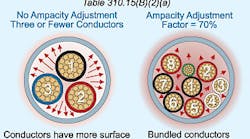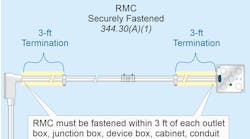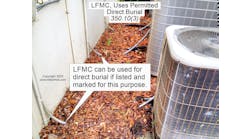All questions and answers are based on the 2008 NEC.
Q. What size THHN conductor is required for a 320A 3-phase feeder load for commercial office buildings?
A. Let's assume the load is continuous, and more than 50% of the load is nonlinear. Follow these steps to get your answer.
Step 1: Feeder overcurrent device [215.3]. Feeder overcurrent devices must have an ampacity of not less than 125% of the continuous loads, plus 100% of the noncontinuous loads. A 400A protection device is required as selected from 240.6(A): 320A × 1.25 = 400A
Step 2: Feeder conductor [215.2(A)(1)]. The minimum feeder-circuit conductor ampacity, before the application of any adjustment and/or correction factors, must be no less than 125% of the continuous load based on the terminal temperature rating ampacities as listed in Table 310.16 [110.14(C)]. The conductor selected must have an ampacity of 400A before the application of ampacity adjustment (320A × 1.25) at 75°C: According to Table 310.16, 600kcmil rated is rated 420A.
Step 3. Determine conductor ampacity after adjustment. The ampacity of a conductor is the current the conductors can carry continuously under specific conditions of use [Art. 100 definition]. Conductor ampacities are listed in Table 310.16 under the condition of no more than three current-carrying conductors bundled together in an ambient temperature of 86°F.
When conductors are bundled together, the ability of the conductors to dissipate heat is reduced. The NEC requires that the ampacity of a conductor be reduced in accordance with the adjustment factors listed in Table 310.15(B)(2)(a) whenever four or more current-carrying conductors are bundled together (Figure). The higher insulation temperature rating of 90°C rated conductors provides a greater conductor ampacity for use in ampacity adjustment, even though conductors must be sized based on the column that corresponds to the temperature listing of the terminals [110.14 (C)(1)].
The ampacity of 90°C 600kcmil conductors (Step 2) after an 80% adjustment factor [Table 310.15(B)(2)(a)] is 380A (420A × 0.80).
Step 4. Verify conductor overcurrent protection. Can a 600kcmil conductor that has an ampacity of 380A be used to supply a 320A continuous when placed on a 400A overcurrent device? Yes. According to 240.4(B): If the ampacity of a conductor does not correspond with the standard ampere rating of a fuse or circuit breaker as listed in 240.6(A), the next-size-up overcurrent device is permitted.
Q. What is the ampacity of three 8 XHHW conductors installed in a wet location at an ambient temperature of 45°C?
A. XHHW conductors are rated 75°C in a wet location [Table 310.13(A)].
Conductor ampacity [75°C] = 50A
Correction factor for ambient temperature [Table 310.16] = 0.82
Corrected ampacity = 50A × 0.82 = 41A
Q. What is the separation distance of communication raceway on the same rack with raceways containing power and lighting conductors?
A. A minimum of 2 inches separation is required between power and communications “conductors,” but there is no minimum separation requirement between power and communications “wiring methods” [800.133].
Q. Is it a Code violation to install 15A-rated duplex receptacles on a 20A circuit?
A. No. Table 210.21(B)(3) allows the use of 15A- or 20A-rated receptacles on 20A circuits.
Q. What is the minimum burial depth for utility telephone and CATV cables?
A. Wiring under the exclusive control of the communications utility is exempt from the NEC (which has no minimum cover requirement), but many cable TV franchises, local ordinances, and state rules specify a minimum cover depth for trunk and distribution cables.
Q. Are 15A or 20A, 125V receptacles within 6 feet of the lab sink in a school science lab required to be GFCI-protected?
A. Yes, all 15A and 20A, 125V receptacles installed within 6 feet of the outside edge of a sink must be GFCI-protected [210.8(B)(5)].
Q. Does the Code require a paddle fan to be switch controlled, or can the paddle fan be wired directly without a switch?
A. It can be direct wired without a switch. The branch-circuit overcurrent device, such the circuit breaker, can serve as the appliance disconnect [422.31(A)].





